Back in 2006 I put together a “Patristic Rosary Project”, digging into the Mysteries we reflect on in recitation of the Rosary through the lens of some texts from the Fathers of the Church. I will have to return to that PRP one day and do some editing and expanding. In the meantime, … here is the post relevant to today’s beautiful feast.
_____
4th Glorious Mystery: The Assumption
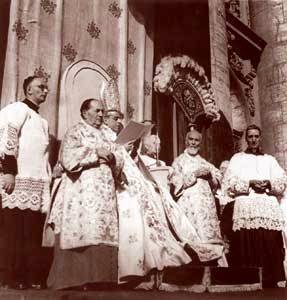 Although Ven. Pius XII refers to Mary’s death in the document whereby he declared infallibly the dogma of the Assumption, and Bl. John Paul II adverts to Mary’s death in a General Audience in 1997 – as do other saintly writers – we do not have from the Church a definitive or infallible teaching beyond a shadow of a doubt whether Mary died and then was assumed body and soul into heaven at that moment or if she was assumed without dying. That said, it was certainly fitting that, if her Divine Son tasted death, then she would as well.
Although Ven. Pius XII refers to Mary’s death in the document whereby he declared infallibly the dogma of the Assumption, and Bl. John Paul II adverts to Mary’s death in a General Audience in 1997 – as do other saintly writers – we do not have from the Church a definitive or infallible teaching beyond a shadow of a doubt whether Mary died and then was assumed body and soul into heaven at that moment or if she was assumed without dying. That said, it was certainly fitting that, if her Divine Son tasted death, then she would as well.
Even in the Eastern tradition, which speaks of the Dormition, the Sleeping, of Mary we have a sub-current of death. Greek κοίμησις gives us κοιμητήριον or Latin coemeterium, whence English “cemetery”, which is a “sleeping place”. Traditions are divided about her last earthly breaths. Some authors hold that she did not die before her Assumption. There is also a strong tradition that she was buried.
Perhaps a good explanation is that Our Blessed Mother, desiring to be like her Son, who did die, chose herself to die though Satan had no hold on her. It was fitting that she, the daughter of her Son and disciple of Her Lord, should be as He was. So, after a brief interval during which no corruption touched her, her soul and body were reunited in heaven in the presence of God.
In any event, we know with our Catholic faith, and by infallible authority, that at the end of her earthly life, the Mother of God was assumed into heaven and no stain of the corruption of the grave touched her.
Our humanity is seated at the right hand of the Father in the divine Person of our Lord, but now also in the human person of our Lady.
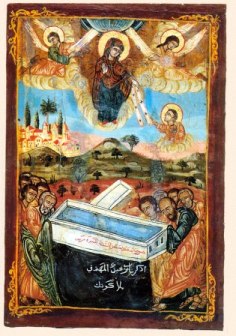 Christ is consubtantial with the Father. Christ is consubstantial with His Mother.
Christ is consubtantial with the Father. Christ is consubstantial with His Mother.
Mary is Mother of a divine Person with two natures. She is not Mother of part of Christ, but Mother of all of Christ in His integrity. And so, we can call her Mother of God and Mother of the Church. Her heavenly Assumption was fitting.
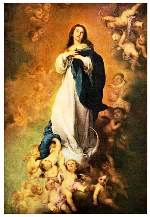 There are not elaborate reflections in the writings of the Fathers on the Assumption, because it was not a main point of theological interest for them. Still, we can find their thoughts on some passages of Scripture which help us to understand Mary’s role in the plan of our salvation.
There are not elaborate reflections in the writings of the Fathers on the Assumption, because it was not a main point of theological interest for them. Still, we can find their thoughts on some passages of Scripture which help us to understand Mary’s role in the plan of our salvation.
As a perfect model for our own Christian discipleship, we can consider, among many texts, Proverbs 8:
And now, my sons, listen to me: happy are those who keep my ways. Hear instruction and be wise, and do not neglect it. Happy is the man who listens to me, watching daily at my gates, waiting beside my doors. For he who finds me finds life and obtains favor from the LORD; but he who misses me injures himself; all who hate me love death.
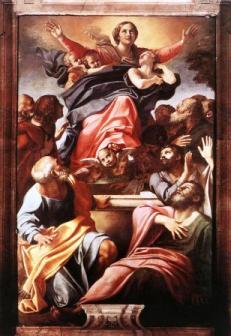 While this concerns Wisdom, in a sense it harks to Mary, Wisdom’s seat. Here is the reflection of Athenagoras on this section of Proverbs:
While this concerns Wisdom, in a sense it harks to Mary, Wisdom’s seat. Here is the reflection of Athenagoras on this section of Proverbs:
[The Son] is the first offspring of the Father, I do not mean that He was created, for, since God is eternal mind, He had His Word within Himself from the beginning, being eternally wise. Rather did the Son come forth from God to give form and actuality to all material things, which essentially have a sort of formless nature and inert quality, the heavier particles being mixed up with the lighter. The prophetic Spirit agrees with this opinion when He says, “The Lord created me as the first of His ways, for His works.” Indeed we say that the Holy Spirit Himself, who inspires those who utter prophecies, is an effluence from God, flowing from Him, and returning like ray of the sun. Who, then, would not be astonished to hear those called atheists who admit God the Father, God the Son, and the Holy Spirit, and who teach their unity of power and their distinction in rank? … We affirm, too, a crowd of angels and ministers, whom God, the maker and creator of the world, appointed to their several tasks through His Word, He gave them charge over the good order of the universe, over the elements, the heavens, the world, and all it contains. [A plea regarding Christians 10]
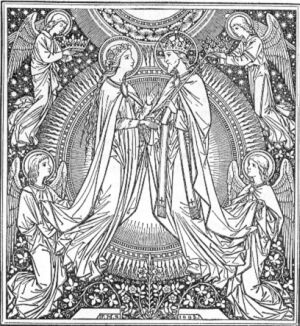 This fellow sounds a bit like a subordinationist, but he is fascinating. This passage is interesting also for its hints at the cosmology and physics of late antiquity. Also, it aims at the spiritual hierarchy in which our wondrous Lady has a privileged place.
This fellow sounds a bit like a subordinationist, but he is fascinating. This passage is interesting also for its hints at the cosmology and physics of late antiquity. Also, it aims at the spiritual hierarchy in which our wondrous Lady has a privileged place.
Consider that the reward of assumption into the beatific vision stems as well from her perfect act of free will when she gave her “Fiat” to God’s will as expressed by the angel. Here is St. Augustine speaking of the impact of free will:
Man in paradise was capable of self-destruction by abandoning justice by an act of will; yet if the life of justice was to be maintained, his will alone would not have sufficed, unless He who made Him glad had given him aid. But, after the fall, God’s mercy was even more abundant, for then the will itself had to be freed from the bondage in which sin and death are the masters. There is no way at all by which it can be freed by itself, but only though God’s grace, which is made effectual in the faith of Christ. Thus, as it is written, even the will by which “the will itself is prepared by the Lord” so that we may receive the other gifts of God through which we come to the Gift eternal – this too comes from God. [Enchiridion 28.106]
God’s grace and Mary’s “Fiat” which was by grace. Mary was drawn with love into God’s plan and, later, into God’s presence. The Fathers made frequent use of the Song of Songs. St. Gregory the Great writes about the exchanges of heaven and earth which marked the plan of salvation:
The Church speaks through Solomon: “See how he comes leaping on the mountains, bounding over the hill!” … By coming for our redemption the Lord leaped! My friends, do you want to become acquainted with these leaps of His? From heaven He came to the womb, from the womb to the manger, from the manger to the Cross, from the Cross to the sepulcher, and from the sepulcher He returned to heaven. You see how Truth, having made Himself known in the flesh, leaped for us to make us run after Him. [Forty Gospel Homilies 29]
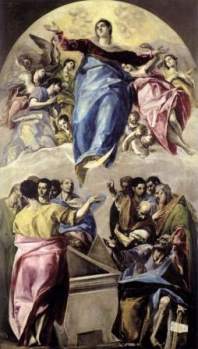 Our Lady, who would feel Christ leap beneath her heart, herself leapt after Christ in her heart by her “Fiat”. She leapt to begin His public ministry when she said at Cana “Do whatever He tell you.” She leapt up Calvary with Him when the Blood and water flowed down. Her motherly and Christian heart leapt in joy in seeing Him gloriously risen. She leapt to Him in heaven when her earthly life was concluded.
Our Lady, who would feel Christ leap beneath her heart, herself leapt after Christ in her heart by her “Fiat”. She leapt to begin His public ministry when she said at Cana “Do whatever He tell you.” She leapt up Calvary with Him when the Blood and water flowed down. Her motherly and Christian heart leapt in joy in seeing Him gloriously risen. She leapt to Him in heaven when her earthly life was concluded.
In heaven Mary shines with the glory God shares with her. In the book of Revelation we have a description chapter 12 of the woman clothed with the sun. The Fathers speak about this image. They will mostly consider the woman as an image of the Church. We cannot reduce the Church to Mary. Nor in talking of the Church as Christ’s Body reduce Christ to the Church. But the three, Christ, Mary and Church are intimately associated. Hippolytus (+245) writes:
By the “woman clothed with the sun”, he meant most manifestly the Church, endued with the Father’s Word, whose brightness is above the sun. And by “the moon under her feet,” he referred to [the Church] being adorned, like the moon, with heavenly glory. And the words “upon her head a crowd of twelve stars” refer to the twelve apostles by whom the Church was founded.
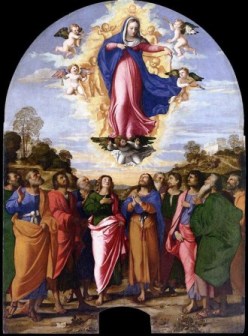 Of course Christ founded the Church on the Apostles, and chiefly upon the Rock who is Peter. The description of the woman, however, fits Mary the Mother of the Church as well as the Church herself. Here is an extended piece by someone not too many in the West may read, Oecumenius (6th c.) called the “Rhetor” who wrote the earliest Greek commentary on Revelation:
Of course Christ founded the Church on the Apostles, and chiefly upon the Rock who is Peter. The description of the woman, however, fits Mary the Mother of the Church as well as the Church herself. Here is an extended piece by someone not too many in the West may read, Oecumenius (6th c.) called the “Rhetor” who wrote the earliest Greek commentary on Revelation:
The vision intends to describe more completely to us the circumstances concerning the antichrist…. However, since the incarnation of the Lord, which made the world his possession and subjected it, provided a pretext for Satan to raise this one up and to choose him [as his instrument] – for the antichrist will be raised to cause the world again to fall from Christ and to persuade it to desert to Satan – and since moreover His fleshly conception and birth was the beginning of the incarnation of the Lord, the vision gives a certain order and sequence to the material that it is going to discuss and begins the discussion from the fleshly conception of the Lord by portraying for us the mother of God. What does he say? “And a sign appeared in heaven, a woman clothed with the sum and the moon was under her feet.” As we said, it is peaking about the mother of our Savior. The vision appropriately depicts her as in heaven and not on the earth, for she is pure in soul and body, equal to an angel and a citizen of heaven. She possesses God who rests in heaven – “for heaven is my throne” – it says yet she is flesh, although she has nothing in common with the earth nor is there any evil in her. Rather, she is exalted, wholly worthy of heaven, even though she possesses our human nature and substance. For the Virgin is consubstantial with us. Let the impious teaching of Eutyches, which make the fanciful claim that the Virgin is of another substance than we, be excluded from the belief of the holy courts together with his other opinions. And what does it mean that she was clothed with the sun and the moon was under her feet? The holy prophet Habakkuk, prophesied concerning the Lord, saying, “The sun was lifted up, and the moon stood still in its place for light.” calling Christ our Savior, or at least the proclamation of the gospel, the “sun of righteousness”. When He was exalted and increased, the moon – that is, the law of Moses – “stood still” and no longer received any addition. For after the appearance of Christ, it no longer received proselytes from the nations as before but endured diminution and cessation. You will, therefore, observe this with me, that also the holy Virgin is covered by the spiritual sun. For this is what the prophet calls the Lord when concerning Israel he says, “Fire fell upon them, and they did not see the sun.” But the moon, that is, the worship and citizenship according to the law, being subdued and become much less than itself, is under her feet, for it has been conquered by the brightness of the gospel. And rightly does he call the things of the law by the word “moon”, for they have been given light by the sun, that is, Christ just as the physical moon is given its light by the physical sun. The point would have been better made had it said not that the woman was clothed with the sun but that the woman enclothed the sun, which was enclosed in her womb. However, that the vision might show that the Lord, who was
being carried in the womb, was the shelter of His own mother and the whole creation, it says that He was enclothing the woman. Indeed, the holy angel said something similar to the holy Virgin: “The Spirit of the Lord will come upon you, and the power of the Most High will overshadow you.” For to overshadow is to protect, and to enclothe is the same according to power. [Commentary on the Apocalypse 12.1-2]
Take careful note of the image drawn on by the interesting Oecumenius, which also speaks to the cosmology of late antiquity. First, Oecumenius either knew that the sun gave light to the moon, as it does, or he extrapolates this from the glory that Christ gives to Mary.
All our Marian feasts, all our reflection, to keep the sunlight and moon theme going, always must draw us back to the Person of the Lord. We reflect on the face of the Lord who is reflected in the face of His Mother.
Our recitation of the Rosary brings us to know the Lord more and more and, in turn, know ourselves better.
We reflect His image and likeness and He came into the word to reveal us more fully to ourselves.

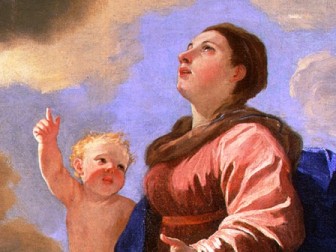 being carried in the womb, was the shelter of His own mother and the whole creation, it says that He was enclothing the woman. Indeed, the holy angel said something similar to the holy Virgin: “The Spirit of the Lord will come upon you, and the power of the Most High will overshadow you.” For to overshadow is to protect, and to enclothe is the same according to power. [Commentary on the Apocalypse 12.1-2]
being carried in the womb, was the shelter of His own mother and the whole creation, it says that He was enclothing the woman. Indeed, the holy angel said something similar to the holy Virgin: “The Spirit of the Lord will come upon you, and the power of the Most High will overshadow you.” For to overshadow is to protect, and to enclothe is the same according to power. [Commentary on the Apocalypse 12.1-2]
































Thank you Fr. Z for this lovely meditation. Book, please.
I wrote an extended Litany of Loreto a very long time ago (finishing it about 1983), which I have put on the blog a few times. You may like to look at it, if you have time. Not as extensive and pastoral as yours, of course.
http://supertradmum-etheldredasplace.blogspot.com/2014/08/stms-litany-of-loreto-rosary-repeat-for.html
Thank you Father for this wonderful meditation which I shall print off and read through the day.
I would like to share some of the text of Ven. Maria de Agreda’ from the “Divine Life of the Most Holy Virgin” regarding the events leading up to the Assumption. According to Ven. Mary of Agreda, the Archangel Gabriel was sent to announce the news 3 years before her passing.
“…Having saluted her by the “Ave Maria,” [Gabriel] continued: “The Omnipotent and the Holy of holies sends us to thy Majesty, to announce the happy end of thy pilgrimage. Only three years still remain ere thou shalt enter for all eternity into the glory of the blessed, who all desire thy presence.”
Our Blessed Mother tells St. John the news….
“….These words grieved the loving heart of St . John; he answered with deep emotion: “My Mother and my Queen, since thou art all-merciful, deign to help thy son who will be left alone and deprived of thy precious company.” Overcome by grief and tears, he could say no more; the merciful Mother consoled and encouraged him; nevertheless, from that day, the Apostle was overwhelmed with sadness and grew faint and languid, like the flowers which fade at sunset. Mary promised that, as a tender Mother, she would ever assist him, and she frequently prayed her Son to strengthen him, that the violence of his sorrow might not shorten his life. St. John revealed the sorrowful tidings to St. James , and both Apostles became more assiduous in visiting their august Mistress. In those three years, the Almighty so disposed events that all nature began to be affected and gave evidence of mourning for the approaching death of her whose life added beauty to all created things. The Apostles, although dispersed throughout the world, felt an ardent desire to behold their Mother and Queen, while the faithful who were near her had a presentiment that they were about to lose their glory and their treasure. The skies, the animals, the birds and all creatures were moved and troubled. During the six months which preceded her death, the sun, moon and stars gave fainter light than ordinary, yet men were ignorant of the cause. St. John alone accompanied these signs by his tears, from which the faithful came to understand the reason. They therefore hastened to the Supper-room to render homage to their Queen; they threw themselves at her feet, asked her blessing and kissed the ground upon which her feet had trod. The Mother of Mercy consoled them all, and though their loss was inevitable, she was moved at their grief, and by her prayers obtained that all the children of the Church should receive the graces and privileges they desired. 1 It would be impossible to describe the immense concourse of people who thronged to see her or the wonderful miracles which she operated during that time. She converted many to the True Faith, brought numbers back to the state of grace, provided for or remedied the wants of the miserable, frequently supplying them miraculously. She confirmed all in the fear of God, in the Faith and in obedience to the Church, and, as treasurer of the divine graces, poured them out upon the children of the Church before departing from them. Moreover, she consoled them all and promised to do much more for them when she should have entered Heaven….”
************
What a beautiful beautiful Mother we have. Ave Maria.
Wonderful meditation Father. I have for some reason been thinking a lot about the cosmological questions that you raised in this piece. The moon has since the apostolic age been a symbol of the Blessed Virgin. And, while some say this is because the Church wanted her to take the place of the goddess Artemis or something like that, I think it far more likely that it was because the light of the Sun reflects off of the moon. Christ has since the earliest days been the Sun of Justice, the Dawn; even going back as far as the Canticle of Zechariah sung on John the Baptist’s naming day. So this is a great theological truth, but it is based on a physical truth: the moon actually does reflect the light of the Sun. And so the question arises: how did the ancients know this? A fascinating and very revelatory question.
We who live in our own oh so sophisticated modern age should not be so quick to dismiss the wisdom of the past or to think of the ancients as a bunch of rubes.
Blessed Mary, the soul God created for His benefit, the soul we are all to have been like, was created before Adam’s and Eve’s. Therefore due to the laws of heredity as we can find in the Old Testament, did not inherit Adam’s sin. Blessed Mary was subject so strongly to the Will of God that Her ecstasies lasted for long times and during those times of perfect prayer God Her Father drew her soul to Him in the Beatific Vision. Finally God so enthralled by her perfection and seeing that even the final temptation of loneliness that followed her physical separation from Her Son and did not despair called Her Body to be assumed into heaven (drawn) to unite as we all will be. Her Body and Soul was broght to her eternal spiritual home.
This is a good meditation. Have you ever considered publishing these in physical form, Father, if not doing an app with all of these and other bits of liturgical excellence?
“Christ is consubstantial with His Mother”
Help me out on this one. Doesn’t this imply that Our Lady has a divine nature?
The ancient world knew that the Moon reflects the Sun, because there are all these phases of the Moon and eclipses to observe.
Insofar as humanity goes, Christ is consubstantial with Mary, and Mary is consubstantial with us. We’re all the same flesh and blood and bone, and we all have human souls. But probably “consubstantial” is confusing here, because we use it only in the specialized theological meaning that refers to divinity, and this is dealing with humanity.
Insofar as divinity goes, we baptized Christians, and Mary, are all part of Christ’s Body, and hence we participate in Christ’s divinity and become more like Him (if we cooperate with His grace). But we aren’t divine and Mary isn’t divine, and we will never be divine ourselves; but if we are part of the Body of Christ, Who is God, we will have His divine life within us forever. So it’s not the same thing, but it’s more than awesome enough.
Hear, hear, Supertradmum. “Book please!”
Josemaria, Christ is consubstantial with his mother because Christ is fully human. If Christ is not consubstantial with us human beings, our salvation cannot be accomplished. One way to describe our salvation is to say that we become partakers of the divine nature (see Peter’s epistles). This was surely accomplished in the case of the Theotokos. Christ must be fully human and fully divine so that we humans can share in the life of the Holy Trinity through union with him.
Indeed. If it helps, consider the dogma of Christ’s two natures (hypostatic union) and the heresy of the Monophysites. Fully human and consubstantial with His mother just as as He is consubstantial with God the Father Almighty.
Eastern theology teaches unambiguously that Mary died and was transferred to life. This is not defined anywhere but we would contend that it is the universal teaching of the church of the first millennium. It is expressly stated in the Byzantine liturgy.
Thank for the clarification, Suburbanbanshee!
Benedicta eius gloriosa Assumptio.
cwillia1 says:
Josemaria, Christ is consubstantial with his mother because Christ is fully human. If Christ is not consubstantial with us human beings, our salvation cannot be accomplished.
1. Let’s distinguish a bit. There is primary and secondary substance, the former referring to the particular existent (e.g., Peter, John Paul II), the latter referring to the nature (e.g., human nature). Christ’s human nature meant that He shares with us the same secondary substance but not the primary.
With God there is no distinction between primary and secondary substance, and so the predication of “consubstantial” in the Credo differs from any possible use of it with regard to man.
2. Christ took on human nature, but God could have saved man without the Incarnation.
(b)
One way to describe our salvation is to say that we become partakers of the divine nature (see Peter’s epistles). This was surely accomplished in the case of the Theotokos. Christ must be fully human and fully divine so that we humans can share in the life of the Holy Trinity through union with him.
1. The Petrine text refers to Grace, not just Christian Grace (which is Adoptive Filiation). In so far as God is Eternal, partaking in the Divine Nature can be limited to the gift of Immortality that was granted to the First Parents.
2. See #2 above.
robtbrown, thanks for that clarification.
Fr Z, this post was very eloquent, and I would be very very happy to read this in book form, where “normal” people read things, instead of on the internet, available only to – well, people on the internet. What I especially like about your commentary is that it gives me hope that, several hundred years from now, theologians will be humble enough (as you were – paragraph four, in particular) to not declare a settled opinion on whether Mary – the Mother of their Lord and Creator – may have had to “die”, even in a minimal sense . I like to think of a future where Mary is respected as she should be (and as she is not now), and I find it absolutely impossible to believe that the beloved mother of our Lord, the mother of the Lord who was able to heal people he had never met on this earth (leaving aside, for the moment, the fact that he had created them) by a simple action of walking through a crowd where they could touch his garment, would be the mother of a Lord who would not have had the divine courtesy to let his own beloved Mother know that, if she died, it would be completely unnecessary; why should there be a single moment in human history – and every moment means something overwhelmingly important to someone somewhere – even I have had one or two of those moments – (there have been several trillion moments since the death of our Lord, and, as a matter of simple mathematics, everyone of the billions of people in this world has had one or more of those trillions of moments completely dedicated by the Lord to herself or himself) – why should there be a single moment in history where the sinless Mother of our Lord is unjustly forced to taste the death that she had no part in and no responsibility for? Noone, voluntarily or not, should be expected to share such an unjustifiably dark moment with her.
Perhaps someone can help me.
I’ve heard but never been able to track down an Eastern (?) tradition that all the Apostles gathered at Mary’s deathbed and subsequent burial. My patron St Thomas was late, as usual, and found the grave empty.
Stephen C says,
why should there be a single moment in history where the sinless Mother of our Lord is unjustly forced to taste the death that she had no part in and no responsibility for?
That’s a good argument, but Christ also unjustly tasted death.
The Dominican Rite refers to the death of the Virgin in the Collect for the Assumption:
Latin text
Veneranda nobis, Domine, huius diei festivitas opem conferat salutarem; in qua sancta Dei genetrix mortem subiit temporalem, nec tamen mortis nexibus deprimi potuit, quae Filium tuum, Dominum nostrum, de se genuit incarnatum. Qui tecum …
Fairly literal translation
May the sacred festival of this day, on which the holy Mother of God endured temporal death, helpus towards salvation, for the bonds of death could not detain her who bore our Lord, your Son incarnate: who lives and reigns …”
The Order wanted to retain this beautiful Collect – quoted by St Albert the Great, among others, when his discusses this point – in its extensive Supplement to the OF Missal (published in 1978) but it was referred to the SCDF (!) who refused to allow it. “La s. Congrégation pour la Doctrine de la Foi …a répondu que, tout en reconnaissant l’antiquité de ce texte, elle juge imopportun de le consever après la Bulle dogmatique Munificentissimus Deus, pour ne pas favoriser dans une texte liturgique une interprétation théologique particulière.”
The Master of the Order pointed out in reply that we had happily reproduced the collect in editions of the Missal after 1950, but concluded reluctantly, “Nous nous inclinons devant la décision de la Sacrée Congregation.” – “We bow to the decision of the Sacred Congregation.”
Of course, since Summorum Pontificum, it is back in at least occasional liturgical use.
– Martin Wallace OP
Blackfriar,
In his book on the BVM, Garrigou LaGrange refers to her death and resurrection. Although the book was published before Munificentissimus Deus, he uses this phrase to describe the Assumption.
TC,
The texts translated in M.R. James, The Apocryphal New Testament are worth reading, if a library near you has the book (in whatever edition: it was updated over the years), or can get it for you on some sort of Inter-library Loan.
More quickly and easily, see The Assumption of Mary under Apocrypha under Church Fathers at the New Advent site!